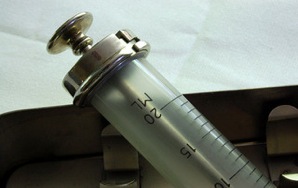Want To Shoot Up? Drug Clinic Will Inject Your Heroin For You

A clinic has been drawing controversy for its novel approach to Vancouver’s drug problem: Instead of letting addicts take drugs on the street, amongst tourists and locals, Insite allows them to do so in the privacy of a medical facility. The operation was founded in 2003 as a response to the city’s rapidly increasing overdose rates throughout the 90s, in a city where heroin and cocaine laws are laxly enforced. Insite is North America’s only “safe house” clinic, although such facilities are more common throughout Western Europe — in countries like Spain and Germany.
To fight street overdoses and promote safe use, clinical coordinator Tim Gauthier says that “staff members and nurses supervise people’s injections.” In a 2011 interview with Paul Hiebert, Gauthier said, “The participants come in with their own drugs. In case a participant overdoses or has a heart attack, someone is there to help. If we can intervene timely and quick, there’s no reason anyone should ever die. That’s our primary function.”
In addition to providing drug assistance, Insite offers its patients health, medical and welfare services — like condoms and information about government assistance programs, for those who qualify. Mr. Gauthier also mentions that the site provides approved equipment for drug users to take with them. These include “condoms, lubrication, needles, cookers [and] filters — everything you need for injecting safely.” Gauthier also stressed, “You could take hundreds of needles if you want. There’s no limit.”
The center stresses confidentiality for its patients, and CNN interviewed “Steve,” a frequent visitor to the clinic who accounts for one of InSite’s approximately 800 daily patients. As the health care workers supervised his heroin injection, Steve claimed that he’s overdosed three different times at the center. He said,
“I’m glad it was here [where I overdosed]. It’s still in my hope that maybe I can get clean. I’m only 48. And that’s why these places…it’s just, it’s common sense. When you have a problem that’s grown for whatever reason to the epic proportions that it has in this city, it’s time to come up with a really good solution, and this is it.”
As Steve hints, the center doesn’t stress rehabilitation for its patients, accepting that many of them don’t want to stop using — or simply won’t. Gauthier said, “We want people to be abstinent, but that’s not our expectation.” Many patients, like Steve, are long-time drug abusers, and the average InSite patient has been using for over two years. According to Gauthier, InSite is “seeing a lot of people that are just really, really sick and really, really entrenched in their addiction.”
However, the center offers drug and alcohol counselors for those seeking treatment for their addictions and a detox program for those whose intent is to kick the habit.
In addition to long-time users, InSite predominantly sees middle-aged men from the Vancouver East Side, where the center operates. The neighborhood is one of the poorest in the entire country, despite the city-at-large’s reputation for having one of the highest qualities of life in the world. In the late 90s, when overdose rates were at their highest, CNN reports that the city had the “highest HIV rate in the developed world.”
The East Side is still home to thousands of IV drug users, many of whom who remain at a higher risk of contract HIV due to needle use. In addition to drug-related ailments, many come in with stab or gunshot wounds. InSite’s services help keep them alive.
However, not everyone agrees with InSite’s model of harm reduction. Despite local support from the Vancouver Police Department at the mayoral level, where the center became a wedge issue during the ‘02 elections, Prime Minister Stephen Harper’s government has long opposed the controversial center. In 2005, Harper spoke on record about the issue and said, “We as a government will not fund drug use.”
In a 2008 op-ed for the Toronto newspaper, Globe and Mail, former Health Minister Tony Clement expanded upon those sentiments: “A more apt analogy of what InSite does…would be a doctor holding a cigarette to make sure a smoker doesn’t burn his lips, or watching a woman with cardiac problems eat fatty French fries to ensure she swallows them properly.”
The issue was brought to Canada’s Supreme Court in 2011, unanimously voting in favor of the center’s legal ability to operate, but InSite continues to face opposition. A bill from the new Health Minister, Leona Aglukkaq, will make it harder for clinics like InSite to stay open. Aglukkaq believes that safe houses should seek community support and consult with local leaders before going into effect. By these rules, InSite will need to prove that it has positively impacted the community around it in order to continue to operate.
Like Harper and Clement, Algukkaq has voiced her stern opposition to Insite. In a press release, the minister said, “Our government believes that creating a location for sanctioned use of drugs obtained from illicit sources has the potential for great harm in a community.” In addition to Algukkaq, Head of the Canadian Police Department Tom Stamatakis believes safe houses “lead to an increase in criminal behaviour and disorder in the surrounding community and have a significant impact on police resources.”
But despite the controversy, Gauthier has seen the impact that InSite has had on the community. 30% of InSite visitors are more likely to get into Detox, and Gauthier stressed the center’s many success stories — like Dean Wilson, an InSite advocate who was the Vancouver Area Network of Drug Users (VANDU). A once frequent visitor to the center’s drug clinic, Wilson hasn’t used in years. Another former drug user is now a children’s book author. Gauthier said, “It’s like a made-for-TV movie.”
However, for those who aren’t so lucky, they will continue to hold on for as long as the Harper government allows the center to operate — in whatever capacity they deem appropriate. Until then, it’s all they’ve got. ![]()



